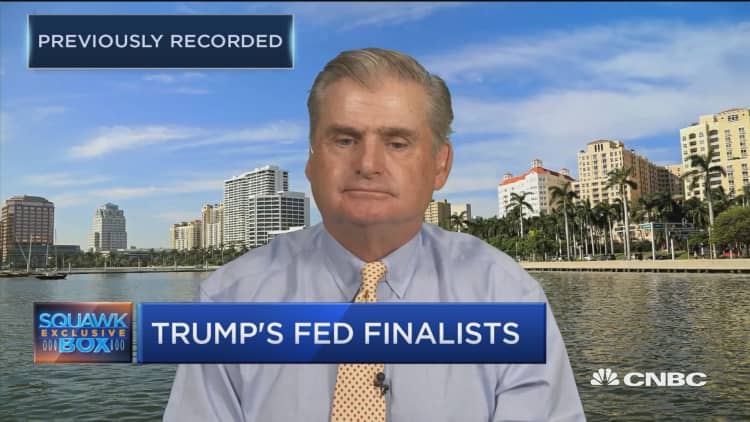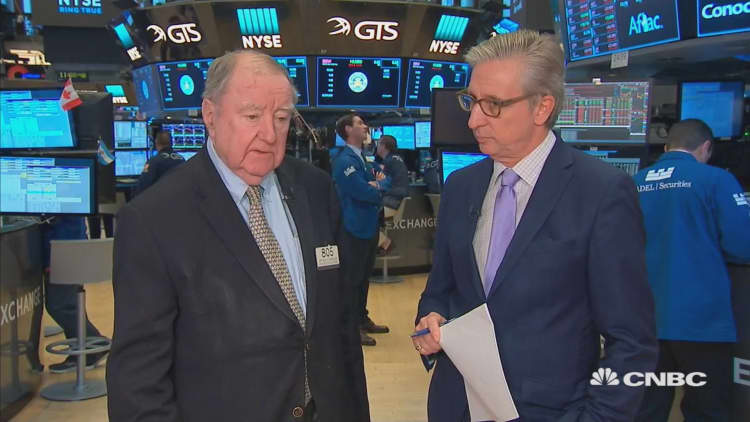
Bond yields snapped higher in a sell-off fueled by stronger-than-expected U.S. economic data, and the expectation that central banks are moving into an era when policy will no longer be so easy and interest rates will head higher.
Treasury yields move opposite price, and the 10-year yield was as high as 2.47 percent Wednesday, the highest since March. At the heart of the sell-off was speculation that President Donald Trump's pick for Fed chair could be the most hawkish choice, Stanford University economist John Taylor.
Taylor contrasts with Yellen in that he has a firm rules-based view, and a rule of his own — the Taylor rule — which outlines specific conditions for rate hikes. The market believes he would expect a much higher neutral rate and a faster hiking pace.

At the same time, the European Central Bank is expected to reduce the amount of bonds it is buying in its quantitative easing program and could outline those plans when it meets Thursday. U.S. rates also take their cue from Europe, and the yields on German bunds have been moving higher.
Add to that a series of stronger-than-expected U.S. economic reports, which boosted expectations that higher inflation could finally be on its way, a missing ingredient that would make interest rate hikes more likely. U.S. durable goods orders jumped 2.2 percent Wednesday, compared with an expected 1 percent increase forecast by economists. New home sales were also up 19 percent Wednesday, to a near decade high with a boost in activity in the storm-hit Southern states.
The 10-year Treasury yield Wednesday screamed higher, after leaping above the technically significant 2.40 percent barrier just Tuesday. The 10-year influences home mortgage rates, as well as other consumer and business loans.
"We can't scream on our own. We need Europe to scream along with us. We can't remain an island unto our own. We need Europe to help push yields higher," said Christopher Rupkey, chief financial economist at MUFG Union Bank. Rupkey said the move by the ECB Thursday could add to the push higher in yields.
The entire Treasury curve was moving higher Wednesday, with the rising above 1.60 percent. The 2-year is most sensitive to Fed rate hiking, and the market expectations for a Fed interest rate hike in December are more than 80 percent.
But it's the outlook for next year and beyond, when the Fed chair will be in place, as well as the potential for as many as three new members. The leading contender in the eyes of the market is Fed governor Jerome Powell, but Taylor gained momentum, particularly after a report Tuesday that Republican Senate leaders supported him in a straw poll taken by the president.
"It's essentially the Fed lottery at this point. I can't imagine how, if I was Donald Trump, how I could view Taylor and Powell as the same," said Michael Schumacher, the director of rate strategy at Wells Fargo.
Schumacher said the 10-year could jump to 2.60 or 2.65 percent if Taylor were nominated. Rupkey said he expects the 10-year at 2.50 percent this year, but it could reach 2.75 percent, depending on who heads the Fed.
"If Taylor gets the nod, we think the curve flattens and short rates go up a lot. He's really the disruptive candidate, and Powell represents continuity," said Schumacher. "You look at it and say, it's a two-horse race, but it's two different horses."
Rupkey said Taylor may not be as hawkish as the market expects. "I think the market is misperceiving what Taylor would do. I don't think he would move rates up more quickly. He may have an idea that the neutral rate for fed funds is more like 4 percent," said Rupkey. The Federal Open Market Committee believes the neutral rate should be 2.75 percent.
"It's a serious political battle here, trying to win over Trump," said Rupkey, adding there have been numerous speculative news stories. "You can't trust any of this."
Schumacher said at the crux of the market move is the belief that the world's major central banks are stepping away from the easy policies they embraced during the financial crisis. The Bank of England, for instance, could raise interest rates when it meets next week.
"I don't want to pour cold water on the rally. ... 2.50 is a real line in the sand," Rupkey said. "We'll see what happens with the GDP data. That's the next big report."
GDP for the third quarter is scheduled to be released Friday, and it's expected to show an increase of 2.5 percent, according to Thomson Reuters.
WATCH: Cashin on what's spooking investors



